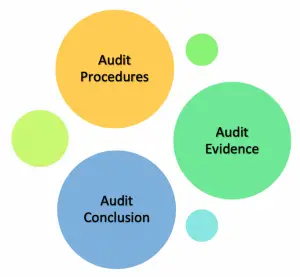Audit Documentation
Definition
Audit documentation, also known as audit working paper, is the record of procedures auditors perform, relevant audit evidence obtained during their audit work and the conclusion they form based on the audit evidence gathered.  Audit documentation could be stored in the form of paper, electronic or other types of media.
Audit documentation could be stored in the form of paper, electronic or other types of media.
It is important for auditors to have proper documentation of their audit work so that it can be used as evidence of the work done to support the audit opinion they form. It also assists audit team members for the whole audit process, starting from the planning stage until the end of the audit engagement.
Purposes of Audit Documentation
Audit documentation can serve many purposes to auditors including being as evidence of their work and conclusion, helping team members in performing audit work including supervision and review, etc.
According to ISA 230, audit documentation serves a number of purposes as included in the table below:
| Purposes of Audit Documentation | |
|---|---|
| 1 | It provides evidence of auditors’ basis for a conclusion about the achievement of the overall objective. |
| 2 | It provides evidence showing that audit work was properly planned and performed in accordance with ISAs and other legal and regulatory requirements. |
| 3 | It assists audit team members to plan and perform their audit work in the engagement. |
| 4 | It assists audit team members who are responsible for supervision to properly direct, supervise and review audit work, both hot and cold review. |
| 5 | It enables audit team members to be accountable for their audit tasks. |
| 6 | It allows the record of matters of continuing significance to be retained. |
| 7 | It enables the conduct of quality control reviews and inspections (both internal and external). |
Content of Audit Documentation
It is not possible or practical for audit to record everything they have done during their audit working starting from day one in the auditing work on the engagement. So, auditors will have to use their experiences and professional judgment to decide which information should be recorded in the content of audit documentation.
Also, the content of audit documentation may be different from one audit engagement to another. This is due to the circumstances of the engagement and audit procedures may be different from one type of client to another depending on the nature and risks of the client.
In this case, auditors should consider several factors when documenting their audit work, as included in the table below:
| Factors to consider when document audit work | |
|---|---|
| 1 | The size and complexity of the client’s business |
| 2 | The nature of audit procedures that are needed to perform |
| 3 | The identified risks of material misstatement that could occur on financial statements |
| 4 | The significance of the audit evidence that have been obtained |
| 5 | The nature and extent of exceptions that have been identified |
Audit Documentation Example
Audit documentation usually starts from the planning stage of the audit until the end of the audit engagement. So, there is a lot of documentation that auditors need to do, so that they can have tangible evidence to show to regulators or other relevant parties.
Some examples of audit documentation include:
- Information obtained in the understanding of the client’s business and control environment.
- Planning process of the audit work
- Analysis of transactions and balances as well as trends and ratios
- Risks of material misstatements identified and assessed in the planning stage
- Evidence of audit procedures performed including nature, timing, extent, and results of the audit as well as how they are supervised and reviewed
- Indication of who performed which audit work and the completion date of such work
- Written representations obtained from the client’s management, etc.